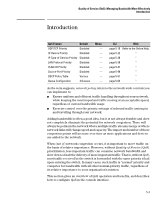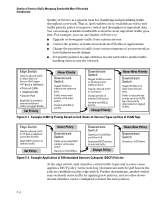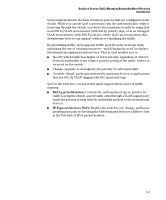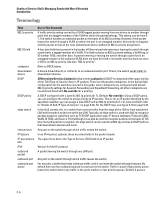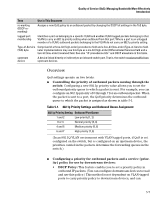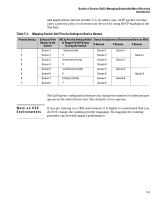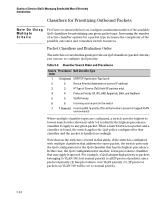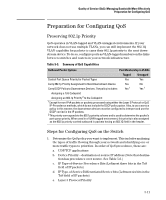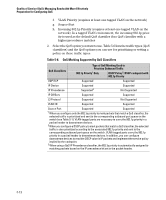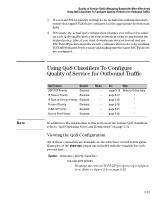HP 6120XG HP ProCurve Series 6120 Blade Switches Advanced Traffic Management G - Page 184
p Priority Rules, Rule and Policy Limits
 |
View all HP 6120XG manuals
Add to My Manuals
Save this manual to your list of manuals |
Page 184 highlights
Quality of Service (QoS): Managing Bandwidth More Effectively Introduction - Change the codepoint (the upper six bits) in the ToS byte. - Set a new 802.1p priority for the packet. (Setting DSCP policies requires IPv4 inbound packets. Refer to the "IPv4" entry under "Terminology" on page 5-6.) • 802.1p Priority Rules: An outbound, VLAN-tagged packet carries an 802.1p priority setting that was configured (or preserved) in the switch. This priority setting ranges from 0 to 7, and can be used by downstream devices having up to eight outbound port queues. Thus, if packets within the switch move at the four priority levels shown in table 5-1, above, they still can carry an 802.1p priority that can be used by downstream devices having more or less than the four priority levels in the switches covered in this guide. Also, if the packet enters the switch with an 802.1p priority setting, QoS can override this setting if configured with an 802.1p priority rule to do so. Notes If your network uses only one VLAN (and therefore does not require VLAN-tagged ports) you can still preserve 802.1p priority settings in your traffic by configuring the ports as tagged VLAN members on the links between devices you want to honor traffic priorities. Rule and Policy Limits: The switches covered in this guide allow up to 250 802.1p priority rules and/or DSCP policies in any combination. For more information, refer to "Maximum QoS Configuration Entries" under "QoS Operating Notes and Restrictions" on page 5-72. You can configure a QoS priority of 0 through 7 for an outbound packet. When the packet is then sent to a port, the QoS priority determines which outbound queue the packet uses: Table 5-2. QoS Priority Settings and Operation QoS Priority Setting Outbound Port Queue 1 - 2 low priority 0 - 3 normal priority 4 - 5 medium priority 6 - 7 high priority If a packet is not in a VLAN-tagged port environment, then the QoS settings in table 5-2 control only to which outbound queue the packet goes. Without VLAN tagging, no 802.1p priority is added to the packet for downstream device use. But if the packet is in a VLAN-tagged environment, then the above setting is also added to the packet as an 802.1p priority for use by downstream devices 5-8



